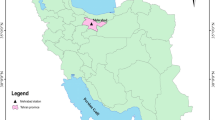Abstract
Artificial neural network model had been implemented in different areas such as industrial processes, sciences, and business. In these days, climatic changes have occurred. In this study, meteorological variables are predicted using ANN model. The experimental values are obtained from the Turkish Meteorological Center for different measurement stations. The prediction of the meteorological values are realized, when the neural network model have been trained and tested. Obtained results show that the difference between estimated and measured values is very low. The neural network models for prediction are successfully applied to the meteorological variables.



Similar content being viewed by others
References
Climate change research at Joint Research Center (2011) European Commision. http://ec.europa.eu/dgs/jrc/index.cfm?id=2290
Elminir HK, Areed FF, Elsayed TS (2005) Estimation of solar radiation components incident on Helwan site using neural networks. Sol Energy 79:270–279
Mubiru J, Banda EJKB (2008) Estimation of monthly average daily global solar irradiation using artificial neural networks. Sol Energy 82:181–187
Sozen A, Arcaklıoğlu E (2005) Effect of relative humidity on solar potential. Appl Energy 82:345–367
Białobrzewski I (2008) Neural modeling of relative air humidity. Comput Electron Agric 60:1–7
Cadenas E, Rivera W (2009) Short term wind speed forecasting in La Venta, Oaxaca, Mexico, using artificial neural networks. Renew Energy 34:274–278
Huang M, Peng G, Zhang J, Zhang S (2006) Application of artificial neural networks to the prediction of dust storms in Northwest China. Global Planet Change 52:216–224
Rehman S, Mohandes M (2008) Artificial neural network estimation of global solar radiation using air temperature and relative humidity. Energy Policy 36:571–576
Santhanam T, Subhajini AC (2011) An efficient weather forecasting system using radial basis function neural network. J Comput Sci 7(7):962–966
Caglar N (2009) Neural network based approach for determining the shear strength of circular reinforced concrete columns. Construct Build Matr 23:3225–3232
Pala M (2006) A new formulation for distortional buckling stress in cold-formed steel members. J Construct Steel Res 62:716–722
Ayata T, Cavuşoglu A, Arcaklıoğlu E (2006) Predictions of temperature distributions on layered metal plates using artificial neural networks. Energy Conv Manag 47:2361–2370
Acknowledgments
We are thankful to directorship of Kocaeli Meteorology in Turkey, for the support in the accomplishment of the present study, directorship manager for his valuable help.
Author information
Authors and Affiliations
Corresponding author
Rights and permissions
About this article
Cite this article
Erdil, A., Arcaklioglu, E. The prediction of meteorological variables using artificial neural network. Neural Comput & Applic 22, 1677–1683 (2013). https://doi.org/10.1007/s00521-012-1210-0
Received:
Accepted:
Published:
Issue Date:
DOI: https://doi.org/10.1007/s00521-012-1210-0




